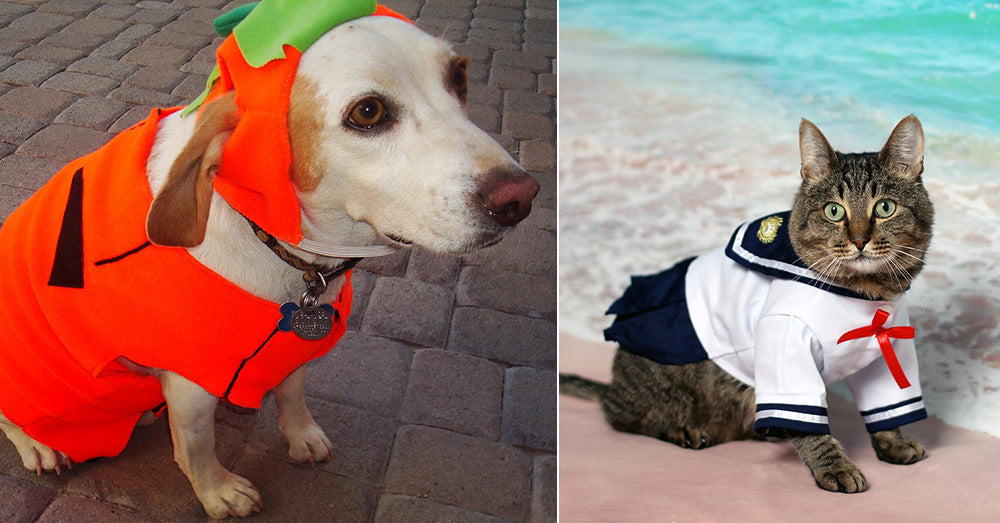How Pet Parents Can Enjoy Halloween And Avoid A Frightful Night
Matthew Russell
Trick or treating is always a sweet opportunity for children, but candy and chocolate can pose serious health problems for pets. Sugar-free alternatives are even worse if they contain Xylitol, a potentially lethal sweetener. And, while we might look forward to the excitement of costumed visitors throughout the night, our animals may find it anxiety provoking.
There are still ways to enjoy this annual event without living in fear, however. If you want to avoid Halloween heartache, here are some ways to keep your pet happy and healthy during the holiday:
 Source: Pixabay
Source: Pixabay5. Know where your pets are
Even the most sociable animals should not be left outdoors on Halloween. While your pets may not feel anxious seeing a parade of costumed characters walk by throughout the night, some of those trick-or-treaters may be less interested in candy than causing mischief.
"Vicious pranksters have been known to tease, injure, steal, and even kill pets on Halloween night," PetMD reports. "Black cats are especially at risk from pranks or other cruelty-related incidents. In fact, many shelters do not adopt out black cats during the month of October as a safety precaution. Make sure your black cats are safely housed indoors around Halloween."
 Source: Pixabay
Source: Pixabay4. Keep the Treats out of reach
Most people understand that chocolate is a no-no for dogs, but it should be kept away from cats, too.
"Chocolate and caffeine belong to a group of plant molecules called methylated xanthine alkaloids, which are commonly found in a variety of foods, drinks and medications," Dr. Medora Pashmakova, clinical assistant professor in Emergency/Critical Care Medicine at the Texas A&M College of Veterinary Medicine & Biomedical Sciences told Modern Dog Magazine. "As stimulants, they cause excitation of the central nervous system, heart rate, and respiratory centers of the brain and can also stimulate the body’s own secretion of adrenaline. And, when in the form of candy and chocolate bars, they taste delicious, which is why dogs love to eat them in such large quantities!"
Sugar-free candies with Xylitol have become popular as a low-glycemic alternative to sweet treats, with the added benefit of fighting dental plaque, but the substance can be deadly to pets.
"Xylitol is extremely toxic to dogs. Even small amounts of xylitol can cause hypoglycemia (low blood sugar), seizures, liver failure or even death in dogs," VCA Hospitals reports.
If you suspect your pet has ingested something toxic, please call your veterinarian or the ASPCA Poison Control Center at (888) 426-4435 immediately.
 Source: Pixabay
Source: Pixabay3. Don't spook the animals
Whether you plan on staying home and handing out candy, or going out and trick-or-treating your self or with children, your pets may not understand why so many costumed visitors seem to be stopping by. To make sure their stress level is kept to a minimum, keep your pets contained in a room away from the front door.
"While opening the door for guests, be sure that your dog or cat doesn’t dart outside," the ASPCA reports. "And always make sure your pet it wearing proper identification—if for any reason he or she does escape, a collar with ID tags and/or a microchip can be a lifesaver for a lost pet."
 Source: Pixabay
Source: Pixabay2. Keep decorations safe
Pumpkins are a'plenty on Halloween night, many of them carved into scary or funny faces. Some people use candles to give their ghoulish gourds a ghastly glow, but this long-held practice may be inviting danger when pets are involved.
A close encounter with a candle-containing jack-o-lantern could result in singed fur, or worse. Moreover, animals that chew on pumpkins could wind up giving themselves a stomachache.
 Source: Pixabay
Source: Pixabay1. Respect your pet's comfort level
Not all pets are interested in dressing up for Halloween. Some would rather go in their natural coat. If your pet doesn't seem to enjoy wearing the outfit you've picked out, don't push it. You may be causing your pet undue stress.
As the ASPCA recommends, "Don’t put your dog or cat in a costume unless you know he or she loves it. If you do dress up your pet for Halloween, make sure the costume does not limit his or her movement, sight or ability to breathe, bark or meow. Check the costume carefully for small, dangling or easily chewed-off pieces that could present a choking hazard. Ill-fitting outfits can get twisted on external objects or your pet, leading to injury.
It's a good idea to give the costume a test run before Halloween night. It can help your pet get used to the feeling, and avoid any possible meltdowns.
 Source: Pixabay
Source: Pixabay

